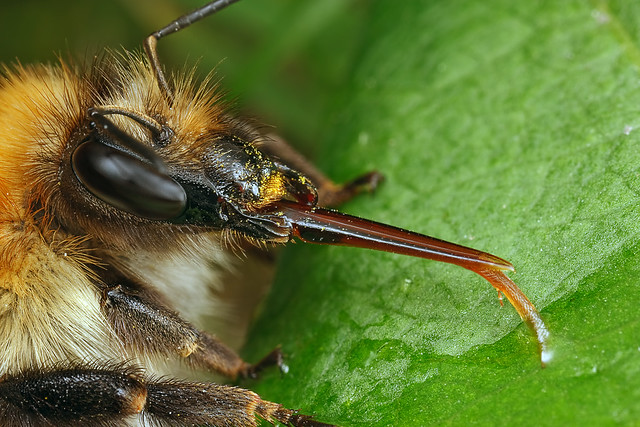You can participate in SciStarter project BeeSpotter(http://www.scistarter.com/project/466-BeeSpotter, and Pollinators.info(http://www.scistarter.com/project/567-Pollinators.info%20Bumble%20Bee%20Photo%20Group) For these projects, you can take pictures of bees and record observations such as where you found most of your bees, and what kind of flower they are on.
You can also plant flowers to help bees, just like with butterflies.
In fact, your butterfly feeders would also probably receive bees, too.
So, what exactly do bees do to help our plants? They pollinate them. When a bee stops at a flower to have a drink of nectar and gather pollen for themselves, pollen rubs off onto the bee. When a bee visits another flower, that pollen rubs off and, with luck, will fall into the pistil, the female part of the flower. When pollen falls into the pistil, it will fertilize the seeds, so allowing the plant to release seeds that will germinate. The majority of plants rely on other organisms to pollinate them. Those other organisms can include butterflies, beetles, and even bats, in some species of flower!
 |
Bees are social insects, them living in a colony where only one bee, the queen, can lay eggs. In fact, if a worker bee tries to lay eggs of its own, the queen will eat the eggs. The queen bee sits in a chamber of the hive while the worker bees forage and feed the larvae. Other bees stay indoors, building new honeycombs for the endless supply of eggs that the queen produces. Unlike any other social insect, bees construct their homes out of a material that only they can produce: wax. Bees build honeycombs, or hexagonal cells made for either storing food, or housing larvae. All the worker bees in a colony are females. There is only one male in a colony, and its only purpose is to mate. The male is known as a drone. Neither the drone nor the queen take any efforts in nest-keeping. |
How do bees communicate? Bees have a very intricate way of communication, using the figure 8, and waggle dance. These dances are performed by a bee in the hive to inform other bees of where nectar lies. If they have been to a rich banquet of nectar, they will return, and waggle their bodies in the direction of the source. There is another form of bee dance, used for the same purpose, but this time it is in a figure 8. Such dances are only performed in the hive. If you happen to be a beekeeper, you may have been lucky enough to see this.
.jpg) |
| A diagram of the waggle dance |
Have you ever wondered how honey is made? Honey is actually made of thickened nectar. First, a bee gathers nectar from a flower. After a long process of swallowing and regurgitation, a bee stores the final product after regurgitation in a honeycomb. However, there is still water inside the mixture. The hexagonal design of the honeycomb, combined with constant fanning by the bees’ wings, causes evaporation to take place, creating the thick, sweet liquid we know as honey. The taste of honey varies depending on what flower the nectar was taken from. That means there can be different types of honey in different countries, since they have different flowers. Only honeybees can produce honey (hence the name honeybee). There are two different major varieties of common bees ( there are many more varieties but I am just giving the ones you are most likely to see every day). The two mentioned are bumblebees and honeybees.
 |
| Bumblebee |
| Honeybee |
Bees do not only need to eat nectar to survive, they also need pollen. Bees collect pollen from the plant and store little balls of it on their hind legs ( notice photo of honeybee above).
This pollen will be brought back to the hive and given to the larvae to eat. Pollen is an important component of a bee's diet especially because it is rich in protein. Nectar is also stored, but in a rather inconspicuous way. Bees store it inside their bodies. Of course, they have to eat something, so some of the pollen and nectar they take for themselves. Bees feed in the same manner that butterflies do, using a nectar extracting tube. However, in the case of bees, the tube is not in a spiral shape. It is in a normal tube shape.

.jpg)


No comments:
Post a Comment